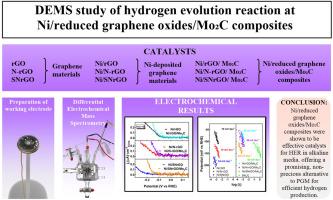DEMS study of hydrogen evolution reaction at Ni/reduced graphene oxides/Mo2C composites
IF 5.6
3区 材料科学
Q1 ELECTROCHEMISTRY
引用次数: 0
Abstract
In the present paper, Ni nanoparticles on graphene-based materials (Ni-GMs) and Mo2C composites (Ni-Mo2C) were tested as electrocatalysts towards the hydrogen evolution reaction (HER) using differential electrochemical mass spectrometry (DEMS) in alkaline medium. Precise determination of the Tafel slope and rate-determining step (RDS), along with the reaction mechanism, was achieved. The findings show that Ni deposition and the addition of Mo2C particles significantly enhance the catalytic activity, leading to low overpotentials towards the HER. Among the tested composites, Ni/rGO/Mo2C demonstrated the best onset potential (-54 mVRHE), followed by Ni/N-rGO/Mo2C (-63 mVRHE) and Ni/SNrGO/Mo2C (-100 mVRHE), with ionic current measurements (m/z = 2) confirming a Volmer-Heyrovsky pathway as the RDS. The addition of Mo2C, while not altering the reaction mechanism, significantly enhanced onset potentials and kinetics, with Tafel slopes for Ni-GMs ranging from 54 to 70 mV·dec−1, underscoring improved HER efficiency. Furthermore, the stability of these composites, particularly Ni/N-rGO/Mo2C, was tested overextended HER operation, showing sustained current densities and reduced degradation. Electrochemical impedance spectroscopy (EIS) revealed that Ni/N-rGO/Mo2C exhibited the lowest charge-transfer resistance, facilitating efficient electron transfer, which likely contributes to its superior durability. The incorporation of heteroatoms such as N and S further enhanced performance by preventing the adverse conductivity effects associated with Mo2C, thereby maintaining high catalytic activity. Collectively, these results indicate that Ni-Mo2C composites could be considered as promising catalysts to be used as cathodes in electrolysers.


Ni/还原氧化石墨烯/Mo2C复合材料析氢反应的dem研究
本文利用差分电化学质谱法(DEMS)测试了石墨烯基材料(Ni-GMs)上的镍纳米颗粒和 Mo2C 复合材料(Ni-Mo2C)在碱性介质中作为氢进化反应(HER)电催化剂的性能。结果精确测定了塔菲尔斜率和速率决定步长(RDS)以及反应机理。研究结果表明,镍沉积和 Mo2C 粒子的加入显著提高了催化活性,从而降低了 HER 的过电位。在测试的复合材料中,Ni/rGO/Mo2C 的起始电位最好(-54 mVRHE),其次是 Ni/N-rGO/Mo2C(-63 mVRHE)和 Ni/SNrGO/Mo2C(-100 mVRHE),离子电流测量结果(m/z = 2)证实了 RDS 是 Volmer-Heyrovsky 途径。Mo2C 的加入虽然没有改变反应机制,但却显著提高了起始电位和动力学,Ni-GMs 的 Tafel 斜率为 54-70 mV-dec-1,突显了 HER 效率的提高。此外,对这些复合材料(尤其是 Ni/N-rGO/Mo2C)的稳定性进行了超长 HER 运行测试,结果表明它们具有持续的电流密度并减少了降解。电化学阻抗光谱(EIS)显示,Ni/N-rGO/Mo2C 表现出最低的电荷转移电阻,促进了有效的电子转移,这可能是其耐久性优异的原因。N 和 S 等杂原子的加入防止了与 Mo2C 相关的不利传导效应,从而保持了较高的催化活性,进一步提高了性能。总之,这些结果表明,Ni-Mo2C 复合材料可被视为用作电解槽阴极的前景广阔的催化剂。
本文章由计算机程序翻译,如有差异,请以英文原文为准。
求助全文
约1分钟内获得全文
求助全文
来源期刊

Electrochimica Acta
工程技术-电化学
CiteScore
11.30
自引率
6.10%
发文量
1634
审稿时长
41 days
期刊介绍:
Electrochimica Acta is an international journal. It is intended for the publication of both original work and reviews in the field of electrochemistry. Electrochemistry should be interpreted to mean any of the research fields covered by the Divisions of the International Society of Electrochemistry listed below, as well as emerging scientific domains covered by ISE New Topics Committee.
 求助内容:
求助内容: 应助结果提醒方式:
应助结果提醒方式:


